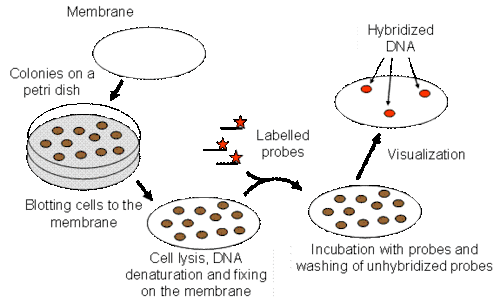Colony hybridization
Colony hybridization is a method of selecting bacterial colonies with desired genes.[1] This method was discovered by Michael Grunstein and David S. Hogness. [2]

Method
Colony hybridization begins with culturing sparsely populated bacterial colonies on a nutrient agar plate. These colonies are symmetrically replicated on a nitrocellulose filter by direct contact, after which the cells on the filter membrane are lysed and their DNA is denatured, allowing it to bind to the filter. These DNA clusters are then hybridized to a desired radioactively-labelled RNA or DNA probe (chosen specifically beforehand) and screened by autoradiography. DNA clusters that exhibit a desired gene are then matched up to the corresponding (living) bacterial colonies, which can be isolated for further growth and experimentation.[2]
Definition of Colony Hybridization:- Colony hybridization is the “Blot analysis technique” where the bacterial cells are transferred from the solid nutrient medium to the absorbent material. Colony hybridization can define as the method for the isolation of the specific DNA sequences or genes from the bacterial cells containing hybrid DNA, by the means of a nitrocellulose membrane filter. The transferring medium then goes through several chemical and physical treatment.
Transferring medium of Colony Hybridization:- The nitrocellulose filter paper is the transferring medium of the colony hybridization which forms replicas of the master plate. The nitrocellulose acts as a membrane which contains the exact copies of the gene to that of the master plate. Nitrocellulose filter paper acts as the “Blotting pad”.
Colony hybridization involves the following steps:
Preparation of Master plate:- First, inoculate the bacterial cell suspension on the solid agar medium to prepare the master plate. After the inoculation, the number of bacterial colonies will develop with different plasmids which refer as “Master or Reference plate”.
Formation of replicas over a nitrocellulose filter:- Then transfer the bacterial cells from the master plate on to the membrane or filter by the means of “Nitrocellulose filter”. Press the nitrocellulose filter paper over the surface of the master plate. This compression of the filter membrane will form replicas or copies of the bacterial cells as that of the master plate.
Treatment of filter medium with SDS:- After that treat the nitrocellulose filter paper with the detergent like SDS (Sodium dodecyl sulfate) to lyse the bacterial cells.
Treatment of filter medium with alkali:- Treat the filter medium with the alkali like sodium hydroxide in order to separate the DNA into single strands.
Fixation of DNA onto the filter medium:- To fix the DNA onto the nitrocellulose filter paper, either bake the filter paper at 80 degrees Celsius or expose it to the UV light.
Addition of radioactive probe:- Hybridize the nitrocellulose filter paper containing imprints of the plasmid DNA by the addition of radioactive RNA probe. This radioactive RNA probe will code the desired gene of sequence from the bacterial cells.
Washing and Autoradiography:- Wash the filter paper to remove unbound probe particles. After that, expose the nitrocellulose filter paper to the X-ray film by the method refer as “Autoradiography”. The colony which will appear after autoradiography will refer as “Autoradiogram” which carry the genes of interest.
Identification of the desired gene:- Then compare the developed autoradiogram with the master plate to identify the colonies containing a gene of interest.
The cells which contain the desired gene can grow in the liquid medium and can further process for the isolation of recombinant plasmid DNA.
Conclusion:- Therefore we can conclude that the colony hybridization method is the “Screening technique” which makes the use of the radioactive probe. The radioactively labelled probe then screen or isolate the particular gene from the number of bacterial colonies.
References
- Rédei, George P. (16 July 2016). Encyclopedia of Genetics, Genomics, Proteomics and Informatics. Springer Netherlands. p. 392. doi:10.1007/978-1-4020-6754-9. ISBN 978-1-4020-6754-9.
- Grunstein, M; Hogness, D S (1975). "Colony hybridization: a method for the isolation of cloned DNAs that contain a specific gene". Proceedings of the National Academy of Sciences. 72 (10): 3961–3965. Bibcode:1975PNAS...72.3961G. doi:10.1073/pnas.72.10.3961. PMC 433117. PMID 1105573.